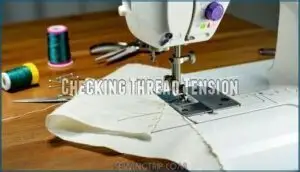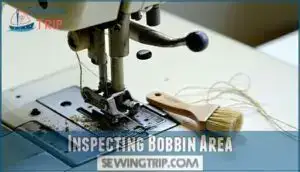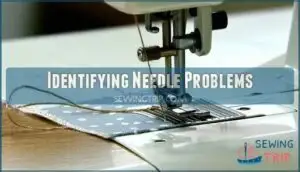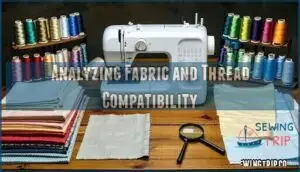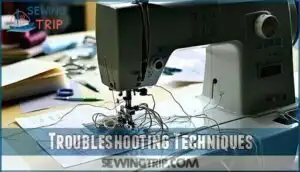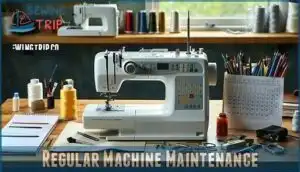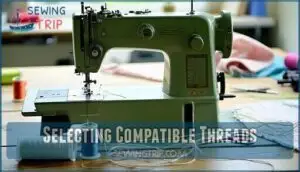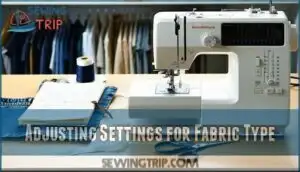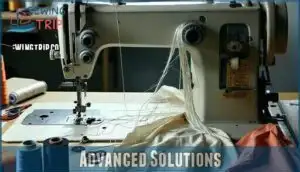This site is supported by our readers. We may earn a commission, at no cost to you, if you purchase through links.
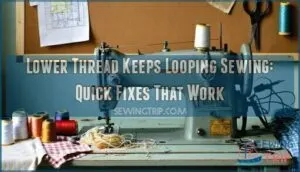
Start by checking your bobbin—it might be wound unevenly or inserted incorrectly.
Loose upper thread tension often causes loops underneath, while too-tight lower tension creates loops on top.
You’ll want to clean out lint from the bobbin case and verify your needle isn’t bent or dull.
Sometimes it’s as simple as using the wrong thread weight for your fabric.
Quality thread makes a difference too—cheap thread breaks down and creates inconsistent tension.
Most loop problems disappear once you balance your tension settings properly and maintain your machine regularly.
There’s more to master than just tension adjustments.
Table Of Contents
Key Takeaways
- Check your tension settings first – Most looping happens because your upper thread tension is too loose or unbalanced with the bobbin tension, so adjust it incrementally and test on scrap fabric
- Inspect your bobbin installation – A crooked bobbin or incorrect threading through the tension spring causes 60% of looping issues, so ensure it sits flat and pulls smoothly
- Replace bent or dull needles immediately – Damaged needles cannot properly catch the bobbin thread, disrupting the interlocking process and creating loops underneath your fabric
- Use quality thread that matches your fabric – Cheap threads break down, create lint buildup, and cause tension inconsistencies, while mismatched thread weights between the top and bobbin create imbalances
Thread Loop Causes
When your lower thread keeps forming loops on the underside of your fabric, you’re dealing with a tension imbalance that’s surprisingly common.
Four main culprits cause this frustrating problem: inconsistent tension settings, incorrect bobbin installation, poor quality threads, and bent or dull needles.
Inconsistent Tension Settings
The most common culprit behind lower thread looping is inconsistent tension settings.
When your tension adjustment isn’t balanced, you’ll see thread tension loops forming underneath your fabric.
Poor thread balance between top and bobbin threads creates sewing machine tension issues.
Irregular sewing speed compounds these problems, especially with varying fabric thickness requiring different bobbin calibration settings for proper tension balance.
To resolve these issues, understanding the correct thread tension settings is essential for achieving balanced stitches and proper tension balance.
Incorrect Bobbin Installation
A crooked bobbin turns your sewing machine into a tangled mess faster than you can say "thread disaster." Incorrect bobbin installation accounts for over 60% of lower thread looping issues, making proper installation your first line of defense against frustrating sewing machine looping problems.
- Check bobbin alignment – Make certain the bobbin sits flat and spins freely in the bobbin case without wobbling or catching
- Verify thread routing – Thread should pull smoothly from the bobbin through the tension spring without resistance or snags
- Confirm bobbin sizing – Use only manufacturer-recommended bobbins as wrong sizes disrupt thread delivery and cause looping
- Test bobbin case fit – The case should click securely into place without forcing or gaps that affect tension adjustment
- Follow installation tips – Insert bobbin with thread pulling counterclockwise to prevent thread looping issues during operation
Poor Quality Threads
When your sewing thread problems persist despite proper tension adjustments, you’re likely dealing with inferior Thread Material that’s causing your thread looping issue.
Cheap threads create lint, break frequently, and disrupt consistent stitching patterns.
| Thread Quality Factor | Poor Quality Impact |
|---|---|
| Fiber Strength | Breaks mid-stitch, creating tangles |
| Yarn Quality | Sheds fibers, clogs machine parts |
| Weave Density | Inconsistent thickness causes tension fluctuations |
| Thread Material | Synthetic blends stretch unpredictably |
| Fabric Durability | Weak threads compromise seam integrity |
Your lower thread issue often stems from bargain-bin spools that seem economical but cost you time and frustration.
Quality threads like Gutermann or Aurifil maintain consistent diameter and tensile strength, preventing the erratic behavior that causes thread keeps looping problems in your sewing thread problems.
Bent or Dull Needles
A damaged needle wreaks havoc on your stitching.
A bent needle turns perfect stitches into tangled disasters faster than you can thread it.
When your needle’s bent or dull, it can’t properly catch the bobbin thread, causing visible loops underneath your fabric.
Needle damage from hitting pins or thick seams disrupts the delicate thread interlocking process.
Check your needle condition regularly and perform needle replacement when you notice thread breakage or sewing errors.
Sharp needles prevent thread looping sewing issues effectively.
Diagnosing Thread Issues
When your lower thread keeps looping, you need to identify the root cause before applying fixes.
Start by checking these four key areas: thread tension balance, bobbin installation and condition, needle sharpness and size, and thread-to-fabric compatibility.
Checking Thread Tension
First, pull up your thread tension settings and test them with scrap fabric. Proper tension adjustment eliminates most thread looping sewing problems when you achieve the right thread balance.
Here’s your systematic approach to checking sewing tension:
- Test current tension settings – Sew a straight line on scrap fabric matching your project material
- Examine stitch formation – Look for loose loops on the fabric underside indicating tension issues
- Adjust tension control dial – Turn incrementally (usually between 3-5 for most fabrics) and retest
- Verify thread settings balance – Make certain both upper and lower sewing machine thread tensions work together smoothly
Inspecting Bobbin Area
Pop open that bobbin case and take a good look around.
You’ll often find the culprit hiding in plain sight – lint buildup, tangled thread paths, or a bobbin that’s sitting crooked.
Clean out every speck of lint with a small brush, check your bobbin alignment, and inspect the bobbin case tension.
This simple bobbin cleaning routine solves most sewing machine looping issues before they become major headaches.
Identifying Needle Problems
Your needle might be the culprit behind those pesky thread loops. Check for needle damage like bent tips or burrs that snag thread during stitching.
Thread breakage often signals needle problems requiring immediate needle replacement. Wrong needle size options create threading mishaps and sewing errors.
Regular needle maintenance prevents needle tension issues. Match your needle selection to thread weight and fabric type for smooth needle threading.
Always make certain you have the correct needle and thread combination to prevent skipped stitches and ensure smooth operation.
Analyzing Fabric and Thread Compatibility
Beyond matching thread weights to fabric thickness, you’re dealing with complex interactions between fiber blends and yarn construction.
Cotton threads excel with natural fabrics, while polyester handles stretch materials better.
Thread compatibility depends on textile science principles – mismatched combinations create tension imbalances that cause loops.
Check your fabric type against thread specifications to prevent compatibility issues, and understanding the correct thread weight chart is essential for achieving superior sewing results with the right thread weight.
Troubleshooting Techniques
When your lower thread keeps looping, you need systematic troubleshooting techniques that address the root cause.
These proven methods will help you identify and fix the specific issue causing your thread problems.
Adjusting Tension Settings
Start by locating your tension dial – it’s usually numbered from 1-9 near the thread guides.
Turn it incrementally, testing each adjustment on scrap fabric. Higher numbers increase tension control, while lower settings reduce thread balance.
Most fabrics work best around setting 4-5. If your sewing machine tension creates thread loops, the bobbin adjustment might also need tweaking.
Proper stitch regulation requires both upper and lower tension working together for smooth looping thread issue resolution. Understanding thread tension issues is essential for achieving the perfect stitch.
Cleaning The Machine
Regular machine cleaning prevents 50% of thread looping issues. Lint buildup in the bobbin area and thread path creates friction that disrupts proper stitch formation.
Clean your machine thoroughly after every 8 hours of use to maintain consistent performance. Using a sewing machine cleaner can help remove tough lint and debris.
To properly clean your machine, follow these steps:
- Remove the needle plate and clean underneath with a small brush
- Clear lint from the bobbin case and hook race area completely
- Oil the hook race according to your manual’s specifications
- Clean thread guides and tension discs with a soft cloth
- Check the thread path for any debris or thread fragments to ensure proper stitch formation and prevent issues like lint buildup and friction.
Using a Tension Gauge
A tension gauge eliminates guesswork when adjusting sewing machine tension.
Remove your bobbin case and insert it into the gauge.
Wind thread around pulleys and slowly pull to get readings between 180-220 grams for most embroidery work.
Clean the bobbin case first since debris affects accuracy.
| Tension Range | Application |
|---|---|
| 180-200 grams | Light embroidery threads |
| 200-220 grams | Standard embroidery work |
| 220-250 grams | Heavy threads, caps |
| Below 180 grams | Causes thread loops |
| Above 250 grams | Risk of thread breaks |
Test your tension adjustment on scrap fabric with contrasting colors.
You’ll see proper stitch balance when 1/3 bobbin thread shows underneath.
Keep a tension log noting thread brands and settings for consistent results across projects.
Resolving Persistent Issues
When tension adjustments don’t solve your sewing machine loop problems, it’s time for deeper troubleshooting. Thread breakage and persistent looping often signal mechanical issues requiring targeted sewing hacks.
- Replace your needle – dull needles cause thread sewing problems regardless of tension control
- Check bobbin case alignment – misaligned cases create looping thread solutions that won’t hold
- Clean the entire thread path – lint buildup disrupts fabric selection and stitch formation
- Test with different thread weights – mismatched threads cause sewing loop fix challenges
- Consider professional servicing – worn parts need expert loop prevention maintenance, which can help resolve issues that require targeted sewing hacks and mechanical issues with looping thread solutions and sewing loop fix challenges.
Preventing Thread Loops
Prevention beats fixing the same problem repeatedly. You’ll save hours of frustration by maintaining your machine properly and choosing the right components for each project.
Regular Machine Maintenance
Every few months, you’ll want to give your machine some TLC to keep those loops at bay.
Machine cleaning removes lint buildup that disrupts thread tension and bobbin tension.
Schedule routine inspection of moving parts, checking for worn components needing part replacement.
Oil change keeps everything running smoothly—consult your manual for specific intervals.
This maintenance scheduling prevents most sewing machine troubleshooting headaches before they start, ensuring a smooth operation with proper TLC.
Choosing The Right Needle
Beyond keeping your machine clean, needle selection plays a major role in preventing thread loops. Wrong needle size or type creates tension imbalances that cause lower thread issues.
Match your needle to both fabric type and thread weight. Here’s what matters most:
- Needle Size: Use 70/10 for lightweight fabrics, 80/12 for medium-weight materials, 90/14 for heavy fabrics
- Thread Compatibility: Fine threads need smaller needles; heavy threads require larger needle eyes
- Fabric Type: Ballpoint needles for knits, sharp needles for wovens, specialty needles for leather or denim
Replace bent or dull needles immediately. Poor needle condition disrupts thread flow and creates loops regardless of your tension settings. Understanding the correct sewing machine needles is vital for achieving superior stitch quality.
Selecting Compatible Threads
Thread compatibility makes or breaks your sewing project. Thread Weight and Fiber Types must match between your upper and lower thread to prevent thread looping.
When sewing thread loop issues persist, check your Yarn Construction compatibility. Thread Colors don’t affect performance, but weight differences create thread tension imbalances.
Your sewing machine loop problems often stem from mixing polyester tops with cotton bobbins. Stick to matching Thread Weight and construction for smooth stitching.
| Thread Issue | Quick Fix |
|---|---|
| Weight mismatch causing loops | Match top/bobbin thread weights exactly |
| Different fiber types tangling | Use identical Fiber Types throughout |
| Poor Fabric Matching results | Select threads designed for your material |
Understanding the correct thread weight systems is essential for achieving balanced stitches and preventing loops.
Adjusting Settings for Fabric Type
When working with different materials, you’ll need to adjust your sewing machine tension settings to match the fabric’s weight and thickness.
Heavy fabrics like denim require looser tension and slower sewing speed, while lightweight materials need tighter thread balance.
Adjust stitch length based on material thickness – shorter stitches for thin fabrics prevent thread loops.
Test bobbin tension and make tension adjustments on scrap fabric first.
To achieve ideal sewing results, understanding thread tension basics is essential for preventing common issues like thread loops and uneven stitches, which can be resolved by mastering sewing machine settings and thread tension.
Advanced Solutions
When basic fixes fail to resolve persistent lower thread looping, it’s time to ponder more intensive solutions.
These advanced approaches target deeper mechanical issues and systemic problems that standard adjustments can’t address.
Professional Repair Options
When basic troubleshooting fails to resolve your sewing machine loop issues, professional repair services become your best option.
Certified technicians can diagnose complex bobbin tension problems and provide accurate repair estimates for persistent thread looping.
Professional sewing machine repair typically includes:
- Comprehensive tension calibration using specialized gauges for factory-standard performance
- Complete cleaning and lubrication to remove compacted lint affecting bobbin tension
- Component replacement for worn tension springs or damaged bobbin cases
Maintenance costs range from $60-$150, depending on your machine’s complexity.
Many repair shops offer warranty coverage and technician tips for preventing future issues.
Replacing Worn Components
Eventually, worn components become the culprit behind persistent thread looping.
Replace your worn needle first—it’s the cheapest fix. Check your bobbin case for cracks or damage that disrupts thread tension.
A damaged hook can catch threads, creating loops every time. Don’t overlook frayed thread guides either.
Even an old machine deserves fresh parts to eliminate stubborn sewing machine loop problems completely, and addressing these issues can help prevent persistent thread looping.
Upgrading to High-Quality Threads
Quality matters when your sewing machine thread keeps looping.
Cheap threads create lint buildup and inconsistent tension, while premium options like Gutermann deliver superior yarn strength and fiber blends.
High-quality threads reduce friction through better weave patterns, backed by textile science research.
Your machine’s thread tension stays balanced, preventing thread looping issues that plague bargain materials.
Using the right thread weight options is essential for achieving professional-looking embroidery results with superior yarn strength.
Advanced Troubleshooting Techniques
When standard fixes fail, Thread Analysis reveals hidden problems.
Check your Diagnostic Tools – pull bobbin thread with slight resistance, examine stitch formation patterns, and test Tension Calibration across different fabric weights.
Sewing Machine Optimization includes timing adjustments and hook alignment verification.
Document thread looping patterns to identify recurring sewing machine tension issues.
Loop Prevention requires systematic elimination of variables until thread tension loops disappear completely.
Frequently Asked Questions (FAQs)
How to fix bottom thread looping?
Picture tangled thread creating a messy bird’s nest beneath your fabric—that’s bottom thread looping driving you crazy.
Check your upper thread tension first, then verify proper bobbin threading and needle condition for smooth stitching.
Why is my bobbin thread looping underneath Reddit?
Your bobbin thread’s looping underneath because there’s a tension imbalance between your top and bottom threads.
Check that you’ve threaded the machine correctly, especially through the tension disks, and adjust your upper thread tension incrementally until balanced, focusing on achieving a proper balance.
Why is the bottom thread on my sewing machine loose?
Your tension’s too tight, threading’s gone wrong, or that bobbin’s wound unevenly. Check your machine’s threading path first, then adjust upper tension incrementally. Clean out lint buildup while you’re troubleshooting.
Why does thread keep looping with new machines?
New machines often loop thread because you’re rushing through setup.
Electronic controls can malfunction, causing erratic tension.
Always test-stitch on fabric scraps first, ensuring proper threading and balanced tension settings before starting your project.
Can weather affect thread looping during sewing?
Like a Victorian seamstress battling stubborn fabric, you’ll find humidity can absolutely wreak havoc on your stitching.
High moisture makes threads swell and stick, creating tension imbalances that cause loops underneath your seams.
Does thread age cause more looping problems?
Yes, old thread definitely causes more looping problems.
Aged thread becomes brittle, loses elasticity, and develops weak spots that create tension inconsistencies.
You’ll notice it breaks easier and doesn’t flow smoothly through your machine’s tension discs, leading to frustrating loops underneath, with tension inconsistencies and looping problems.
Why do decorative stitches create more loops?
Why do decorative stitches create more loops than straight stitches? Complex patterns change thread direction frequently, requiring varying tension adjustments your machine can’t automatically accommodate, causing uneven thread flow.
Can sewing speed changes reduce thread looping?
Sewing speed absolutely affects thread looping.
Slower speeds give your machine’s timing mechanisms better control over thread tension balance.
High speeds can cause the upper thread to outpace the bobbin thread, creating those annoying loops underneath your fabric, which is why slower speeds are often preferred.
Conclusion
Like a ship captain traversing stormy seas, you’ve weathered the challenge of thread loops by mastering the fundamentals.
Your lower thread keeps looping sewing problems won’t return when you maintain proper tension balance, use quality materials, and keep your machine clean.
Remember that prevention beats correction—regular maintenance and choosing the right needle-thread-fabric combination will keep your stitches smooth.
With these techniques in your toolkit, you’ll confidently tackle any threading challenge that comes your way, using proper tension and the right needle-thread-fabric combination.
- http://wp.me/P5JCk7-fw
- http://www.threadsmagazine.com/2008/11/02/understanding-thread-tension
- https://ohyoucraftygal.blogspot.com/2013/10/sewing-lesson-10-how-to-fix-tension-on.html
- https://quiltingwemple.com/troubleshoot-sewing-machine-tension/
- https://www.gillymacdesigns.com/2021/03/how-can-i-tell-if-my-sewing-machine-tension-is-correct/

